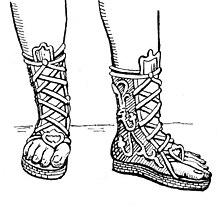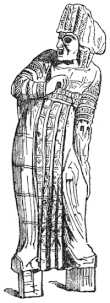Kothurn
The Kothurn (from Greek kothornos ) was originally a laced, calf-high shaft boot, a hunting boot of Dionysus , which later became part of the costume of the actors in the Greek tragedy . In the 2nd century BC The soles were made of cork . The soles were so thick that they almost resembled stilts, which is especially true in Roman times.
High Kothurne were also part of Italian fashion in the 15th and 16th centuries, especially in Venice, and also to Spanish fashion of the late 16th and early 17th centuries. However, they now called themselves Chopine , from Spanish chapín . The ladies wore them under the cone-shaped hoop skirt ( vertugadin ) to appear taller and slimmer. However, they were not visible because the skirt was made longer than necessary; this makes the legs look unusually long.
In a figurative sense, the term Kothurn is also used for tragedy itself.
In addition, the expression Kothurn can be found in the title of the magazine Maske und Kothurn , published by the Institute for Theater, Film and Media Studies at the University of Vienna . This is also where the outdated phrase go along with high Kothurn , as much as speaking in tragic pathos.
literature
- Ludmila Kybalová, Olga Herbenová, Milena Lamarová: The great image lexicon of fashion - from antiquity to the present , translated by Joachim Wachtel, Bertelsmann, 1967/1977.
Web links
Individual evidence
- ^ Charles Victor Daremberg , Edmond Saglio (ed.): Dictionnaire des Antiquités Grecques et Romaines . Volume 1.2. Hachette, Paris 1887, p. 1545 Fig. 2026 ( digitized ).
- ↑ Ludmila Kybalová, Olga Herbenová, Milena Lamarová: The great image lexicon of fashion - from antiquity to the present , translated by Joachim Wachtel, Bertelsmann, 1967/1977: p. 164, p. 172 (Fig. 239), p. 574.

